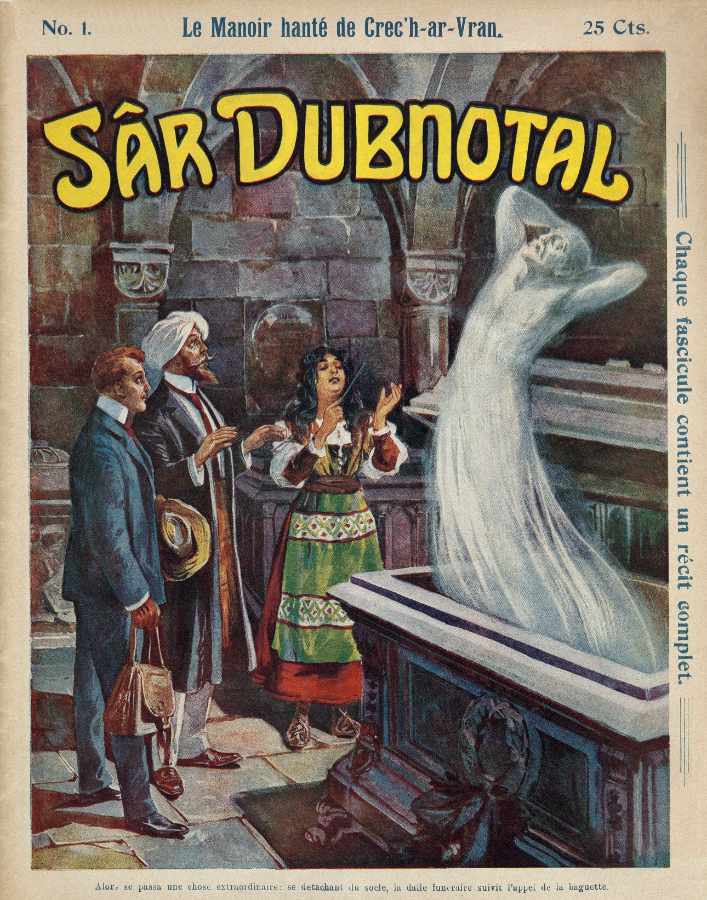Sâr Dubnotal was trained in the west as a doctor and psychologist, and trained in the eastern art of the Hindu yogis, thus possessing a wide range of skills. Dubnotal was the “Conquistador of the Invisible Ones,” the “Napoleon of the Immaterial,” the “Great Psychagogue,” the “grand spirit guide,” a psychic investigator or occult detective, and a master of the Rosicrucian arts. He also referred to himself as “El Tebib,” or “Severus el Tebib,” and “The Doctor,” to emphasize his learned nature. He was medically trained and was an excellent psychologist. He was also trained in the Lombroso method, and could recognize the criminal “type” by simply looking at them. However, Dubnotal was better known as a master of “psychognosis.” Powers included hypnosis, telepathy, and levitation. There is “no phenomenon of somnambulism, of telepathy, of ‘telepsychics’, of levitation, hypnotism, magnetism, suggestion and autosuggestion” beyond him. Dubnotal was “instructed in the school of the brahmins and the most famous Hindu yogis,” and has “victories without number over the battle champions of the invisible.” Dubnotal wore a Hindu turban and was steeped in Indian/Hindu culture. He lived in a spacious apartment in the rooms below his laboratory. At one point, he buried himself alive in order to dispel his lethargy. His friends and enemies included: Gianetti Annunciata, a “petticoated” medium who combined, in her manner, the “gay working girl” and the “high priestess,” who could communicate with the dead, assisted by a small “spiritual telegraph” machine; Tserpchikopf the Hypnotist, who actually turns out to be Jack the Ripper; Azzef, a Russian terrorist; Rudolph, his disciple, a European youth he rescues from gypsies and teaches his knowledge; Naini, his Hindu servant; and a trio of researchers/detectives named Frank (an Englishman), Frejust (a Frenchman) and Otto (a German). Read more: https://thepulp.net/pulpsuperfan/2013/05/10/sar-dubnotal-occult-detective/.
| Alias Sâr Dubnotal |
| Real Names/Alt Names Sâr Dubnotal, “Conquistador of the Invisible Ones”, “Napoleon of the Immaterial”, “Great Psychagogue”, “Grand Spirit Guide”, “Grand Spirit Hunter” |
| Characteristics Hero, Doctor, Magician, Scientist, Pulp Characters, Ghost-themed, Occult, Hypnotist, Magic Caster, Flight, Telekinesis, Telepath, Magnetism, Belle Époque, French, Middle Eastern |
| Creators/Key Contributors Norbert Sévestre, Unknown |
| First Appearance “Le Manoir Hanté de Creh’h-ar-Vran” (“The Haunted Manor of Creh’h-ar-Vran”) in Sâr Dubnotal #1 (1909) |
| First Publisher Eichler |
| Appearance List Sâr Dubnotal #1-20 (1909-1910): “Le Manoir Hanté de Creh’h-ar-Vran” (“The Haunted Manor of Creh’h-ar-Vran”), “La Table Tournante du Docteur Tooth” (“Dr. Tooth’s Turning Table”), “Le Puits Fatal” (“The Fatal Well”), “Le Médium Tragique” (“The Tragic Medium”), “La Grêve Sanglante” (“The Bloody Beach”), “La Détraquée du Passage Rimbaut” (“The Madwoman of Passage Rimbaut”), “Tserpchikopf, le Sanglant Hypnotiseur” (“Tserpchikopf, the Bloody Hypnotist”), “La Piste Astrale” (“The Astral Trail”), “L’Écartelée de Montmartre” (“The Quartered Woman of Montmartre”), “Jack l’Éventreur” (“Jack the Ripper”), “Haine Posthume” (“Posthumous Hatred”), “La Fiancée de Gibraltar” (“The Fiancée from Gibraltar”), “Les Vampires du Cimetière” (“The Vampires of the Cemetery”), “L’Empreinte Rouge” (“The Red Mark”), “La Somnambule du Gué Sanglant” (“The Somnambulist of the River of Blood”), “L’Affaire Azzef-Poloukhine” (“The Azzef-Poloukhine Case”), “Un Complot Terroriste” (“A Terrorist Plot”), “Dans l’Enfer Sibérien” (“In the Siberian Hell”), “Azzef, le Roi des Agents Provocateurs” (“Azzef, King of the Agents Provocateurs”), “Double-Taf, le Dernier des Pentyerns” (“Double-Taf, Last of the Pentyerns”). |
| Sample Read ○ |
| Description Sâr Dubnotal was trained in the west as a doctor and psychologist, and trained in the eastern art of the Hindu yogis, thus possessing a wide range of skills. Dubnotal was the “Conquistador of the Invisible Ones,” the “Napoleon of the Immaterial,” the “Great Psychagogue,” the “grand spirit guide,” a psychic investigator or occult detective, and a master of the Rosicrucian arts. He also referred to himself as “El Tebib,” or “Severus el Tebib,” and “The Doctor,” to emphasize his learned nature. He was medically trained and was an excellent psychologist. He was also trained in the Lombroso method, and could recognize the criminal “type” by simply looking at them. However, Dubnotal was better known as a master of “psychognosis.” Powers included hypnosis, telepathy, and levitation. There is “no phenomenon of somnambulism, of telepathy, of ‘telepsychics’, of levitation, hypnotism, magnetism, suggestion and autosuggestion” beyond him. Dubnotal was “instructed in the school of the brahmins and the most famous Hindu yogis,” and has “victories without number over the battle champions of the invisible.” Dubnotal wore a Hindu turban and was steeped in Indian/Hindu culture. He lived in a spacious apartment in the rooms below his laboratory. At one point, he buried himself alive in order to dispel his lethargy. His friends and enemies included: Gianetti Annunciata, a “petticoated” medium who combined, in her manner, the “gay working girl” and the “high priestess,” who could communicate with the dead, assisted by a small “spiritual telegraph” machine; Tserpchikopf the Hypnotist, who actually turns out to be Jack the Ripper; Azzef, a Russian terrorist; Rudolph, his disciple, a European youth he rescues from gypsies and teaches his knowledge; Naini, his Hindu servant; and a trio of researchers/detectives named Frank (an Englishman), Frejust (a Frenchman) and Otto (a German). Read more: https://thepulp.net/pulpsuperfan/2013/05/10/sar-dubnotal-occult-detective/. |
| Source Sâr Dubnotal – Public Domain Super Heroes Wiki |

